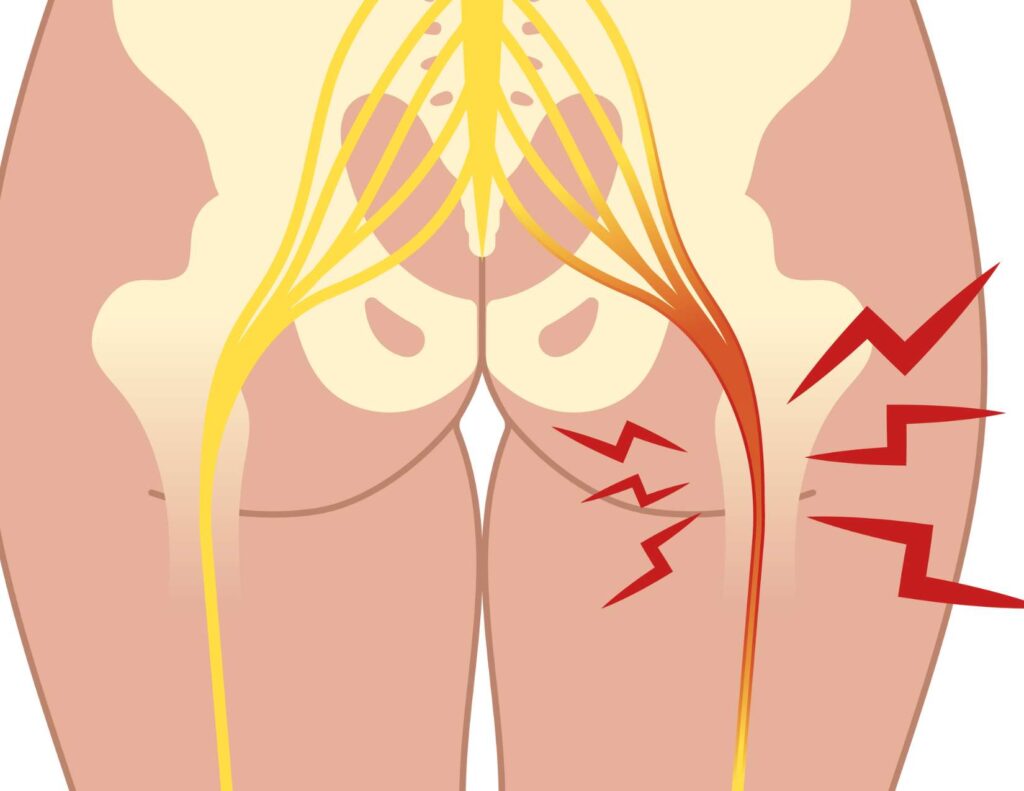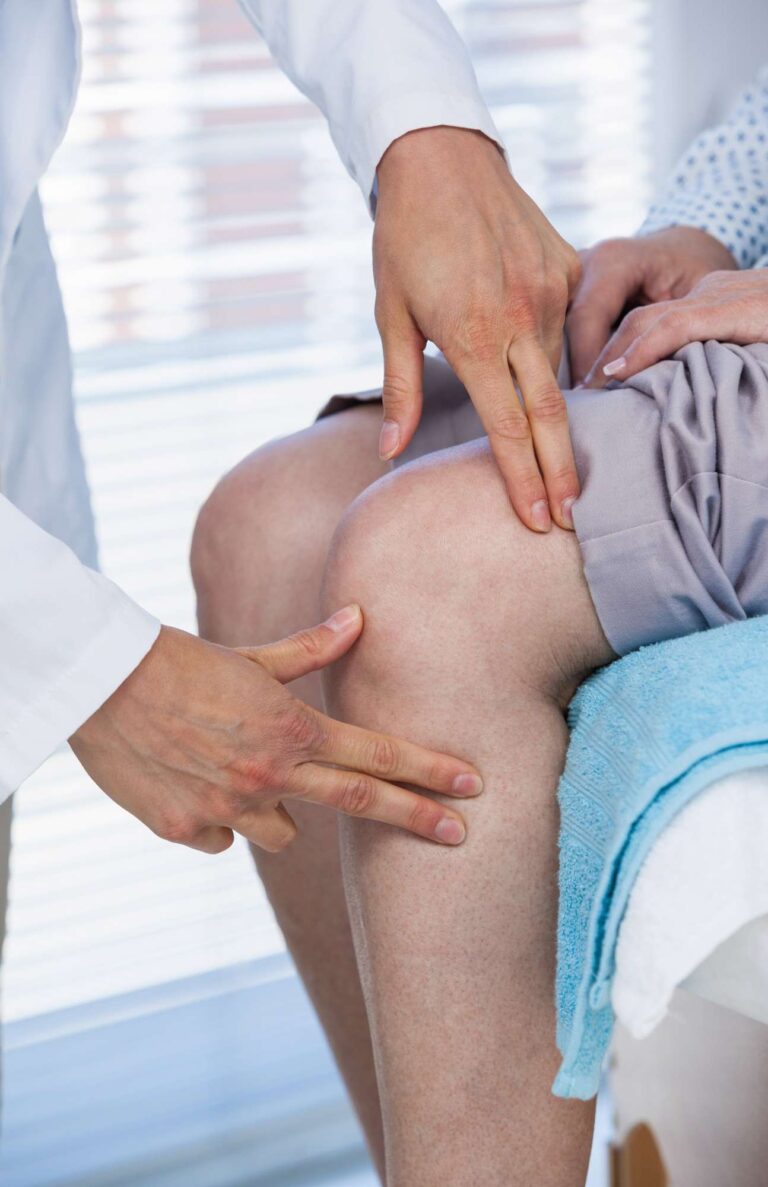Piriformis Syndrome vs Sciatica: Which One is Affecting You?
As a chiropractor, I’ve come across many patients who’ve complained of pain in their buttocks or lower back. More often than not, the pain is caused by either piriformis syndrome or sciatica. These two conditions may have similar symptoms, but they are, in fact, quite different. In this article, I will take you through the anatomy of the buttocks and the sciatic nerve, the causes, symptoms, diagnosis, treatment options, and preventative measures for piriformis syndrome vs sciatica.

Table of Contents
Understanding the Anatomy of the Buttocks and the Sciatic Nerve
Before we dive into the differences between piriformis syndrome vs sciatica, it’s important to understand the anatomy of the buttocks and the sciatic nerve. The buttocks are made up of several muscles, including the gluteus maximus, gluteus medius, and piriformis muscles. The sciatic nerve runs from the lower back, through the buttocks, and down each leg. It’s the longest nerve in the body and is responsible for controlling the muscles in the legs.
The piriformis muscle sits deep in the buttocks, running from the base of the spine to the femur bone. It helps to rotate the hip and stabilize the pelvis. The sciatic nerve runs beneath the piriformis muscle, and in some people, it passes through the muscle. When the piriformis muscle becomes tight or spasms, it can put pressure on the sciatic nerve, causing pain and discomfort.

Causes and Symptoms of Piriformis Syndrome
Piriformis syndrome is a condition that occurs when the piriformis muscle becomes tight or spasms, causing pressure on the sciatic nerve. The exact cause of piriformis syndrome is not always clear, but it’s often associated with overuse, injury, or prolonged sitting. People who participate in activities that involve repetitive use of the hip or those who sit for long periods are at a higher risk of developing piriformis syndrome. Also, it’s common to experience piriformis syndrome in pregnancy due to the changes in posture and hormones during that time.
The most common symptom of piriformis syndrome is pain in the buttocks, which may radiate down the back of the leg. The pain may be sharp or dull and may worsen with activity. Some people may also experience numbness or tingling in the affected leg.

What Causes Sciatica Buttock Pain?
Unlike piriformis syndrome, sciatica is not a condition in itself, but rather a symptom of an underlying issue such as a herniated disc or spinal stenosis, for example. Sciatica occurs when the sciatic nerve becomes compressed or irritated. The most common cause of sciatica is a herniated disc, which occurs when the soft inner core of a spinal disc protrudes through the outer layer of the disc and presses on the nerve.
The symptoms of sciatica are similar to those of piriformis syndrome and include pain in the buttocks, back of the leg, and foot. The pain may be sharp or dull and may be accompanied by numbness or tingling in the affected leg. In severe cases, people may experience weakness in the affected leg.

Diagnosis of Piriformis Syndrome and Sciatica
The diagnosis of piriformis syndrome and sciatica typically involves a physical examination and a review of the person’s medical history. In some cases, imaging tests such as an MRI or X-ray may be required to determine the underlying cause of the pain.
Piriformis Syndrome Self Test
To diagnose piriformis syndrome, a doctor may perform a physical exam to assess the range of motion of the hip and may perform a piriformis syndrome test. This involves stretching the piriformis muscle to see if it causes pain. Another way to test yourself if you have piriformis syndrome is to press directly on the piriformis muscles. If you experience any discomfort or pain, it is most likely the piriformis muscle to blame for the buttock pain.

To diagnose sciatica, a doctor may perform a physical exam to assess the range of motion of the spine and legs. Imaging tests such as an MRI or X-ray may be required to determine the underlying cause of the pain.
**When dealing with piriformis syndrome vs sciatica, it’s important to note that imaging does not always explain why you may be experiencing pain. Sometimes there is clear evidence of a disc protrusion but the person may not have any pain. Likewise, some people may experience excruciating pain but nothing will be detected through imaging.
How to Heal Piriformis Syndrome Quickly
The treatment options for piriformis syndrome typically involve a combination of rest, ice, and at-home management. Resting the affected area and applying ice can help to reduce inflammation and alleviate pain. Certain exercises such as stretching and strengthening the muscles in the buttocks and legs can help to relieve pressure on the sciatic nerve.

***When I’m in a pinch (literally!) with piriformis muscle pain, I combine piriformis muscle stretches and trigger point therapy with a lacrosse ball or a basic tennis ball. I locate the sore area while sitting on the ball or against a wall and apply pressure for 30 to 60 seconds. This usually does the trick to keep the tightness at bay.
In some cases, medication such as nonsteroidal anti-inflammatory drugs (NSAIDs) may be prescribed to help reduce inflammation and alleviate pain. Steroid injections may also be used to reduce inflammation in the affected area.
Treatment Options for Sciatica
The treatment options for sciatica depend on the underlying cause of the pain. In cases where a herniated disc is the cause, the treatment may involve rest, ice, and physical therapy. Seeing a chiropractor for sciatica pain is often times beneficial. In rare cases, surgery may be required to remove the herniated disc.
In cases where spinal stenosis is the cause of sciatica, the treatment may involve physical therapy exercises to relieve pressure on the nerve. In some cases, medication such as muscle relaxants or opioids may be prescribed to alleviate severe pain.

Stretches and Exercises for Piriformis Syndrome and Sciatica
Stretches and exercises can be an effective way to relieve pain and pressure on the sciatic nerve. For piriformis syndrome, exercises that stretch and strengthen the muscles in the buttocks and legs can be beneficial. Examples of such exercises include the piriformis stretch, hip flexor stretch, and glute bridge.

For sciatica, exercises that target the muscles supporting the spine, such as the lower back and core muscles, can help to relieve pressure on the nerve. Examples of such exercises include the cat-camel stretch, pelvic tilt, and bird dog.
Preventative Measures for Piriformis Syndrome and Sciatica
There are similar preventative measures for piriformis syndrome vs sciatica that people can take to reduce their risk of developing either condition. Maintaining good posture while sitting and standing can help to reduce the pressure on the spine and buttocks. Regular exercise, such as walking or swimming, can help to strengthen the muscles in the buttocks and legs.

Avoid certain exercises that may aggravate sciatica. Also, be aware of activities that involve repetitive use of the hip, such as running or cycling, can also help to reduce the risk of developing piriformis syndrome. People who sit for long periods should take frequent breaks to stretch and move around.
Differences between Piriformis Syndrome vs Sciatica
When comparing piriformis syndrome vs sciatica, they may have similar symptoms but they are caused by different underlying issues. Piriformis syndrome occurs when the piriformis muscle becomes tight or spasms, putting pressure on the sciatic nerve. Sciatica, on the other hand, is a symptom of an underlying issue such as a herniated disc or spinal stenosis.
The treatment options for piriformis syndrome vs sciatica also differ, depending on the underlying cause of the pain. Piriformis syndrome may be treated with rest, ice, and physical therapy exercises, while sciatica may require surgery in some severe cases.
How do I know if I have sciatica or piriformis syndrome?
Sciatica and piriformis syndrome are both conditions that can cause leg pain, but they have different causes. Sciatica is typically caused by a herniated disc or spinal stenosis in the lower back, while piriformis syndrome is caused by irritation of the sciatic nerve from a tight or spasming piriformis muscle in the buttocks. To determine which condition is causing your leg pain, it is important to visit a doctor and get an accurate diagnosis.
What does piriformis syndrome pain feel like?
Piriformis syndrome pain can vary in intensity, but it is generally described as a deep, dull ache located in the buttocks. This type of pain may radiate down the leg and be accompanied by tingling or numbness. It can also cause extreme sensitivity to pressure when sitting or lying down. In some cases, the pain may become worse when walking, climbing stairs, or running. It is also possible to experience Piriformis Syndrome pain in just one side of the body.
What are 3 common causes of piriformis syndrome?
1. Repetitive movements, such as sitting for long periods of time or performing activities that involve repetitive motions. 2. Injury to the area, such as a direct impact on the buttocks or an indirect injury due to falls or overstretching during physical activity. 3. Tightness in the muscles surrounding the piriformis, such as hamstrings and gluteus muscles. These tight muscles can put excessive pressure on the piriformis, leading to inflammation and pain. Additionally, having poor posture or an imbalanced muscular system can contribute to the development of the condition.
What causes piriformis to flare up?
Common causes of piriformis flare-ups include overuse of the muscle due to repetitive motions like running or sitting for long periods, injury due to a fall or other trauma, poor posture and pregnancy. Other potential causes include medical conditions like diabetes or arthritis, inflammation due to infection, and anatomical defects such as a short leg.
Can you have piriformis syndrome and sciatica at the same time?
Yes, it is possible to have piriformis syndrome and sciatica at the same time. This can occur when the piriformis muscle in your buttocks becomes inflamed or irritated and presses against the sciatic nerve, causing pain along its path down the back of your leg. This irritation can cause tingling, burning sensations, and pain in the hip and buttocks. Piriformis syndrome is a condition and sciatica is a symptom.

Conclusion
In conclusion, when taking a closer look into piriformis syndrome vs sciatica, they both are conditions that can cause pain and discomfort in the buttocks and legs. While they may have similar symptoms, they are caused by different underlying issues and require different treatment approaches. Stretches and exercises can be an effective way to relieve pain and pressure on the sciatic nerve, and preventative measures such as maintaining good posture and avoiding repetitive activities can help to reduce the risk of developing these conditions. If you are experiencing pain in your buttocks or legs, it’s important to seek medical advice to determine the underlying cause of the pain and to receive appropriate treatment.







